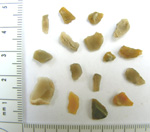Flint flakes

Click ^ for larger image.
These tiny pieces of flint are the waste products of tool production. As a flint nodule is struck repeatedly, a process called knapping, many fragments are broken off, some large enough to form into smaller tools, some much too small to be of any practical use. Gradually, by removing the unwanted flint, the tool is sculpted into its desired shape. These are some of the discarded flakes struck away when knapping a flint tool.
Such tiny pieces of stone are easily overlooked, but a scatter of these would always be left behind at the site where a flint tool was made. Sometimes they can be pieced back together like a 3D jigsaw.
A scatter like this, which contains flakes from many different flint nodules (characteristically having different colours, textures, etc), may indicate a settlement site, where many tools were fashioned over many years. These are likely to date to the Neolithic period of the Stone Age.
Material: stone
Period: Stone Age (or Bronze Age)
Find spot: Hampstead Road, Brislington, Bristol. ST 612710
Exhibit contributed by Ken Taylor
Text written by Ken Taylor, in 2011
Photographer: Ken Taylor
Acquisition number: 110521a2